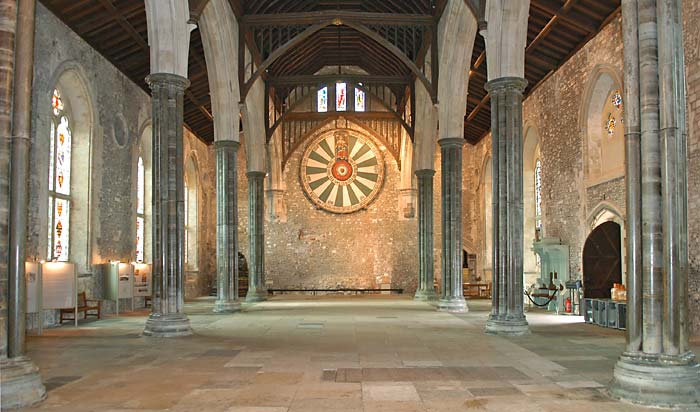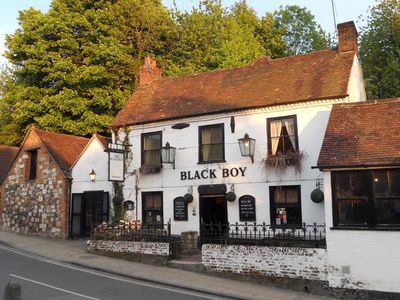
XCalibur 2019
July 15-18 2019 • Winchester, UK
Social Programme
 A handy list of Winchester restaurants and pubs.
A handy list of Winchester restaurants and pubs.
Outline:
JULY 14 SUNDAY: ~6 pm. Informal drink at the Bishop on the Bridge pub. The pub also sells dinner. JULY 15: Evening pub crawl (of course!) between some excellent Winchester pubs (see below). JULY 16: free evening. JULY 17: Conference dinner at the Winchester Cathedral Annex. Free evensong at 5:30 pm will be the best time for those wishing to see the Cathedral inside. JULY 18: noon excursion to Stonehenge.Winchester and Social Events in XCalibur
The area around Winchester has been inhabited since prehistoric times. Winchester came under Roman control after their conquest of Britain, leading to the building of its stone walls at the beginning of the third century. In 648 AD, King Cenwalh of Wessex erected the Church of St Peter and St Paul, which became a cathedral in the 660s. The present form of the city dates to reconstruction in the late 9th century, when King Alfred the Great ruled Wessex. Winchester is commonly described as the ancient capital of Wessex. It has a superb selection of British pubs! And of course, the programme allows for ample time for leisurely lunches and evenings out.Main Sights

City Cross: Winchester High Street
The City Cross (also known as the Buttercross) has been dated to the 15th century, and features 12 statues of the Virgin Mary, saints and various historical figures. Several statues appear to have been added throughout the structure's history.Winchester Cathedral
Winchester Cathedral was originally built in 1079 and remains the longest cathedral in Europe. It contains much fine architecture spanning the 11th to the 16th century and is the place of interment of numerous Bishops of Winchester (such as William of Wykeham), Anglo-Saxon monarchs (such as Egbert of Wessex) and later monarchs such as King Canute and William Rufus, as well as the novellist Jane Austen. It was once an important pilgrimage centre and housed the shrine of Saint Swithun. The ancient Pilgrims' Way travelling to Canterbury begins at Winchester. The plan of the earlier Old Minster is laid out in the grass adjoining the cathedral. Winchester Cathedral Close contains a number of historic buildings from the time when the cathedral was also a priory. Of particular note is the Deanery, which dates back to the thirteenth century. It was originally the Prior's House, and was the birthplace of Arthur, Prince of Wales, in 1486. Not far away is Cheyney Court, a mid fifteenth-century timber-framed house incorporating the Porter's Lodge for the Priory Gate. It was the Bishop's court house. The earliest hammer-beamed building still standing in England is situated in the Cathedral Close, next to the Dean's garden. It is known as the Pilgrims' Hall, as it was part of the hostelry used to accommodate the many pilgrims to Saint Swithun's shrine. Left-overs from the lavish banquets of the Dean would be given to the pilgrims who were welcome to spend the night in the hall. It is thought by Winchester City Council to have been built in 1308.The Great Hall
Winchester is well known for the Great Hall of its castle, which was built in the 12th century. The Great Hall was rebuilt sometime between 1222 and 1235, and still exists in this form. It is famous for King Arthur's Round Table, which has hung in the hall from at least 1463. The table actually dates from the 13th century, and as such is not contemporary to Arthur. Despite this it is still of considerable historical interest and attracts many tourists. The table was originally unpainted, but was painted for King Henry VIII in 1522. The names of the legendary Knights of the Round Table are written around the edge of the table surmounted by King Arthur on his throne. In the grounds of the Great Hall is a recreation of a medieval garden.Guildhall
The Guildhall Winchester is a magnificent Victorian building, dating from 1871 in the Gothic revival style. The Guildhall was originally part of a larger complex, housing the law courts, police station and fire brigade but the greater part was given over to civic roles. The building is now used as an events venue, and is the workshop venue!Pubs: A selection
Join us for a famous British 'pub crawl' on the first evening. There is an abundance to choose from.
The Black Boy
An interesting, quirky pub, furnished with old tables and chairs, and decorated with an eclectic mix of art, clutter and taxidermy. Serves food as well as a good selection of beers.The Eclipse Inn
A small, comfortable, very old and very traditional pub with a great atmosphere. The premises has existed in Winchester since around 1540, and today retains a traditional charm rare amongst city centre pubs. Only serves drinks in the evening - good selection of beers!The Wykeham Arms
Since 1755, when it was a coaching inn, there has been a pub on the site of the Wykeham Arms - Lord Nelson himself was said to have stayed here on his way to Portsmouth. By the mid-1900s it had become the somewhat avant-garde Fleur-de-lys bar, set right across the road from Winchester's then-famous red light district. Nowadays it is a more traditional establishment, full of British memorabilia and partly furnished with Victorian school desks. Serves food and a good selection of beers.The Royal Oak
The Royal Oak Pub is housed in a building built around 1630, but it is believed that there has been a pub on the site for over a thousand years, making it one of the oldest in England. The building also boasts plenty of royal history - it is believed that King Edward the Confessor (1003-1066) spent significant time there in his early years. Royalist supporters during Oliver Cromwell's rule frequented the property - reflected via 'Royal' attribution after Charles II's restoration to the throne. The earliest royal connection with the Royal Oak dates to 1002 when King Ethelred the Unready, whose son, to be King Edward the Confessor, almost certainly spent part of his early years on the property. During Oliver Cromwell's rule the Royal Oak was a notorious haunt of the city's royalist supporters. Following the restoration of Charles II to the throne the inn gained its present name.Stonehenge

Stonehenge is a world-heritage prehistoric monument, whose origins continue to spark debate and a sense of wonder. Massive stone rings form the core of the complex set in the Wiltshire countryside. The monument probably served multiple purposes, including hosting burial mounds, and acting as a marker for astronomically significant dates.
We will have a guided tour of the complex and a leisurely time to roam around the complex an soak in history. The cost of £40 for the excursion covers the coach trip as well as entry and the tour. A packed lunch will also be provided for the day. A trip not to be missed!


